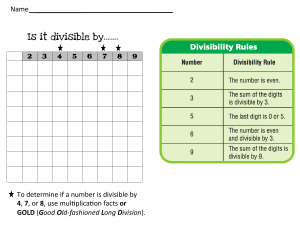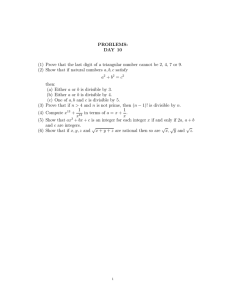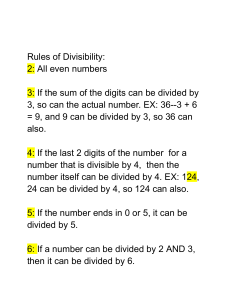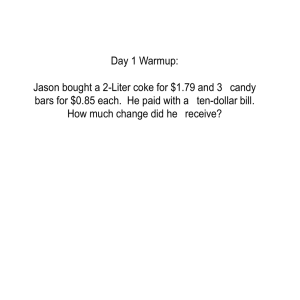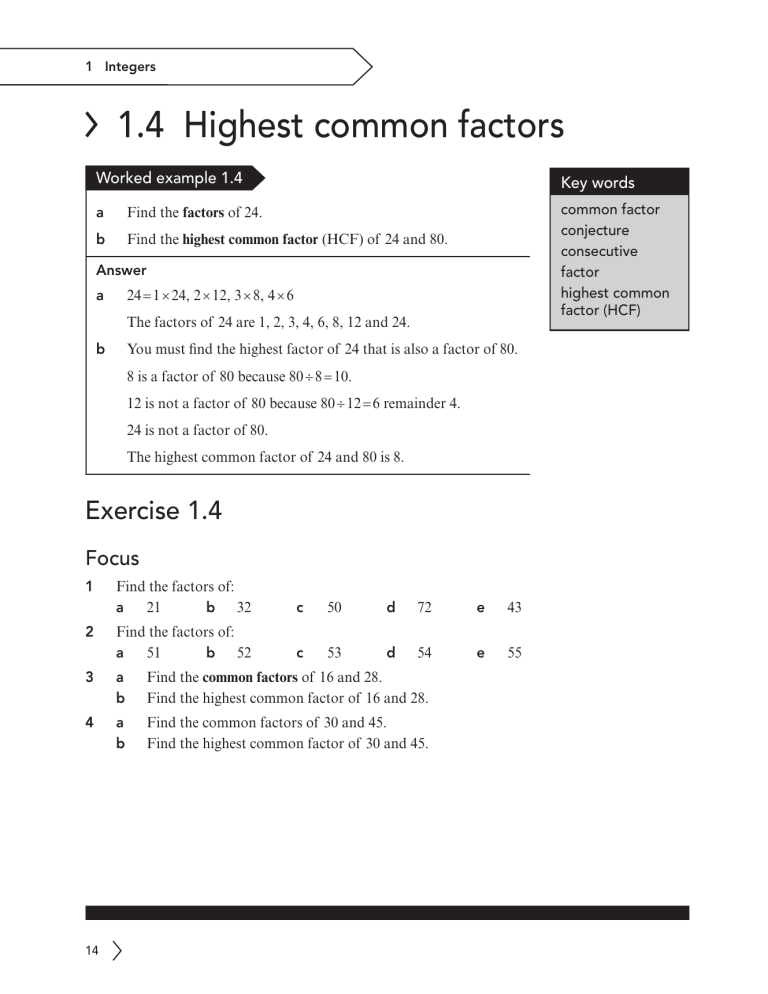
1 Integers 1.4 Highest common factors Worked example 1.4 Key words a Find the factors of 24. b Find the highest common factor (HCF) of 24 and 80. common factor conjecture consecutive factor highest common factor (HCF) Answer 24 = 1 × 24, 2 × 12, 3 × 8, 4 × 6 a The factors of 24 are 1, 2, 3, 4, 6, 8, 12 and 24. b You must find the highest factor of 24 that is also a factor of 80. 8 is a factor of 80 because 80 ÷ 8 = 10. 12 is not a factor of 80 because 80 ÷ 12 = 6 remainder 4. 24 is not a factor of 80. The highest common factor of 24 and 80 is 8. Exercise 1.4 Focus 1 2 Find the factors of: a 21 b 32 c 50 d 72 e 43 Find the factors of: a 51 b 52 c 53 d 54 e 55 3 a b Find the common factors of 16 and 28. Find the highest common factor of 16 and 28. 4 a b Find the common factors of 30 and 45. Find the highest common factor of 30 and 45. 14 1.4 Highest common factors Practice 5 6 7 8 9 Find the highest common factor of: a 18 and 21 b 18 and 27 c 18 and 36 Find the highest common factor of: a 27 and 45 b 50 and 75 c 40 and 72 Find the highest common factor of: a 70 and 77 b 70 and 85 c 70 and 84 d a b Find the highest common factor of 32 and 40. Use your answer to part a to simplify the fraction 32 . a b Find the highest common factor of 52 and 91. There are 91 rooms in a hotel. 52 rooms are reserved. What fraction of the rooms are reserved? 24 and 35 40 Challenge 10 Two numbers have a highest common factor of 5. The two numbers add up to 35. Show that there are three possible pairs of values for the two numbers. 11 The HCF of two numbers is 4. Both numbers are more than 4 and less than 30. a Show that the numbers could be 8 and 12. b Show that the numbers are not 8 and 16. c Find all the other possible values of the two numbers. 12 The HCF of two numbers is 3. One of the numbers is 9. What are the possible values of the other number? 13 a b c Find the highest common factor of: i 9 and 10 ii 20 and 21 iii 32 and 33 9 and 10 are consecutive numbers. 20 and 21 are consecutive numbers. Use part a to make a conjecture about the highest common factor of two consecutive numbers. What is the lowest common multiple of two consecutive numbers? 15 1 Integers 1.5 Tests for divisibility Worked example 1.5 Key words Use tests for divisibility to show that 3948 is divisible by 3 and 6 but not by 9. divisible tests for divisibility Answer The sum of the digits is 3 + 9 + 4 + 8 = 24. 24 is divisible by 3, so 3948 is also divisible by 3. 3948 is even and divisible by 3, so 3948 is also divisible by 6. 24 is not divisible by 9, so 3948 is also not divisible by 9. Exercise 1.5 Focus 1 Use tests for divisibility to show that 5328 is divisible by 4 and by 9. 2 a b Show that 2739 is divisible by 11. When the digits are reversed, the number is 9372. Is 9372 divisible by 11? Give a reason for your answer. 3 a b Show that 67 108 is divisible by 4. Is 67 108 divisible by 8? Give a reason for your answer. 4 The number 3812* is divisible by 3. The final digit is missing. What can you say about the missing digit? Practice 5 What integers less than 12 are factors of 7777? 6 a b se the digits 5, 4, 2 and 1 to make a number that is divisible by: U i 5 ii 3 Can you arrange the digits 5, 4, 2 and 1 to make a number that is divisible by: i 9? ii 11? 7 322 is divisible by 7. Use this fact to find a number that is divisible by 7, 2 and 3. 8 Find the smallest positive integer that is not a factor of 2520. Give reasons for your answer. 16 1.6 Square roots and cube roots 9 Here are some numbers where all the digits are 9: 9 99 999 9999 99999 ... In numbers where all the digits are 9, which are multiples of 11? Challenge 10 A number is divisible by 15 if it is divisible by 3 and 5. a Show that 7905 is divisible by 15. b The number 208** is divisible by 15. Find the possible values of the two missing digits. 11 Find three numbers less than 20 that are factors of 3729. Give reasons for your answers. 12 Show that 8897 is divisible by only one number between 1 and 12. 13 The numbers 4, 5, 6, … are consecutive numbers; for example, 4567 is a number with four consecutive digits. Find all the numbers with four consecutive digits that are divisible by: a 2 b 3 c 5 d 11 1.6 Square roots and cube roots Worked example 1.6 Key words Work out 3 125 − 49 . consecutive cube number cube root square number square root Answer 53 = 5 × 5 × 5 = 125, so 3 125 = 5. 72 = 7 × 7 = 49, so 49 = 7. 3 125 − 49 = 5 − 7 = −2 Exercise 1.6 Focus 1 Work out: a 32 + 42 b 6² + 72 c 92 + 102 17 1 Integers 2 3 4 5 Work out: a 64 b 100 c 225 Work out: a 13 + 23 b 33 + 53 c 43 − 23 Work out: 64 − 3 64 a b 25 − 3 125 c 3 27 − 16 Work out: 3 216 a b 512 c 3 1000 3 d d 169 3 1728 Practice 6 7 8 Copy and complete: a = 20 b Copy and complete: 3 =6 a b 3 = 25 c = 10 c 3 c 3 Find the integer that is closest to: 38 b a 220 9 = 30 d = 11 d = 35 3 = 15 70 45 is between 6 and 7. Write down a similar statement for: 90 135 b a 10 Mustafa thinks of a number. The number is between 100 and 200. The square root of the number is a multiple of 3. What is Mustafa’s number? 11 a b ind all the numbers between 100 and 200 that have an integer F square root. Find all the numbers between 100 and 200 that have an integer cube root. Challenge 12 Find the highest common factor of 12 + 22 + 32 and 42 + 52 + 62. 13 Jiale thinks of a number. She works out the square root of the number. Then she works out the cube root of the square root of the number. The answer is 2. a Find Jiale’s number. b Show that Jiale gets the same answer if she finds the cube root first and then the square root. 18 1 Integers 1.1 Factors, multiples and primes Exercise 1.1 Focus 1 2 3 4 5 6 Draw a factor tree for 250 that starts with 2 × 125. Can you draw a different factor tree for 250 that starts with 2 × 125? Give a reason for your answer. c Draw a factor tree for 250 that starts with 25 × 10. d Write 250 as a product of its prime factors. a Draw a factor tree for 300. b Draw a different factor tree for 300. c Write 300 as a product of prime numbers. a Write as a product of prime numbers i 6 ii 30 iii 210 b What is the next number in this sequence? Why? Work out a 2×3×7 b 22 × 32 × 72 c 23 × 33 × 73 a Draw a factor tree for 8712. b Write 8712 as a product of prime numbers. Write each of these numbers as a product of its prime factors. a 96 b 97 c 98 d 99 a b Key words factor tree highest common factor (HCF) lowest common multiple (LCM) prime factor Practice 7 8 Write as a product of prime numbers a 70 b 702 c 703 a Write each square number as a product of its prime factors. i 9 ii 36 iii 81 iv 144 v 225 vi 576 vii 625 viii 2401 7 1 Integers b When a square number is written as a product of prime numbers, what can you say about the factors? c 176 400 = 24 × 32 × 52 × 72 Use this fact to show that 176 400 is a square number. 9 315 = 32 × 5 × 7 252 = 22 × 32 × 7 660 = 22 × 3 × 5 × 11 Use these facts to find the highest common factor of a 315 and 252 b 315 and 660 c 252 and 660 10 60 = 22 × 3 × 5 72 = 23 × 32 75 = 3 × 52 Use these facts to find the lowest common multiple of a 60 and 72 b 60 and 75 c 72 and 75 11 a Write 104 as a product of its prime factors. b Write 130 as a product of its prime factors. c Find the HCF of 104 and 130. d Find the LCM of 104 and 130. 12 a Write 135 as a product of prime numbers. b Write 180 as a product of prime numbers. c Find the HCF of 135 and 180. d Find the LCM of 135 and 180. Challenge 13 a Write 343 as a product of prime numbers. b Write 546 as a product of prime numbers. c Find the HCF of 343 and 546. d Find the LCM of 343 and 546. 14 Find the LCM of 42 and 90. 15 a Find the HCF of 168 and 264. b Find the LCM of 168 and 264. 16 a Show that the LCM of 48 and 25 is 1. b Find the HCF of 48 and 25. 17 The HCF of two numbers is 6. The LCM of the two numbers is 72. What are the two numbers? 8 1.2 Multiplying and dividing integers 1.2 Multiplying and dividing integers Exercise 1.2 Key word Focus integer 1 2 3 4 Copy this sequence of multiplications and add three more multiplications in the sequence. 7 × −4 = −28 5 × −4 = −20 3 × −4 = −12 1 × −4 = −4 Work out a −5 × 8 b −5 × −8 c −9 × −11 d −20 × −6 Put these multiplications into two groups. A −12 × −3 B (−6)2 C −4 × 9 D 18 × 2 E 9 × −4 F −4 × −9 Copy and complete this multiplication table. × −6 5 −8 5 −4 −9 −45 −16 Work out a (3 + 4) × 5 b (3 + −4) × 5 c (−3 + −4) × −5 d (3 + −4) × −5 d (−4.09)2 Practice 6 7 8 Estimate the answers by rounding numbers to the nearest integer. a −2.9 × −8.15 b 10.8 × −6.1 c (−8.8)2 Show that (−6)2 + (−8)2 − (−10)2 = 0 This is a multiplication pyramid. Each number is the product of the two numbers below. For example, 3 × −2 = −6 a Copy and complete the pyramid. b Show that you can change the order of the numbers on the bottom row to make the top number 3456. –6 3 –2 –1 4 9 1 Integers The product of two integers is −6. Find all the possible values of the two integers. b The product of two integers is 6. Find all the possible values of the two integers. 10 a Here is a multiplication: −9 × −7 = 63 Write it as a division in two different ways. b Here is a different multiplication: 12 × −7 = −84 Write it as a division in two different ways. 11 Work out a 42 ÷ −7 b −50 ÷ −10 c 27 ÷ −3 d −52 ÷ −4 12 Estimate the answers by rounding numbers to the nearest 10. a 92 ÷ −28.5 b −41 ÷ −18.9 c 83.8 ÷ −11.6 9 a Challenge 13 Copy and complete this multiplication pyramid. 270 15 –3 –3 14 Find the value of y. a −8 × y = 48 b y × −3 = −36 c −10 × y = 120 d y × −5 = −40 15 Find the value of z. a z ÷ −4 = −8 b z ÷ −2 = 20 c −36 ÷ z = 9 d 30 ÷ z = −6 16 a Here is a statement: −3 × (−6 × −4) = (−3 × −6) × −4 Is it true or false? Give a reason to support your answer. b Here is a statement: −24 ÷ (−4 ÷ −2) = (−24 ÷ −4) ÷ −2 Is it true or false? Give a reason to support your answer. 10 e d 60 ÷ −5 −77 ÷ 19 1.3 Square roots and cube roots 1.3 Square roots and cube roots Exercise 1.3 Key words Focus natural numbers rational numbers 1 2 3 Work out a 142 b Work out a 43 If possible, work out a −64 c (−14)2 d (−20)2 (−30)2 b (−6)3 c (−10)3 d (−1)2 + (−1)3 b 3 −64 c 3 −125 d 3 d x2 + 121 = 0 d x3 + 8000 = 0 d x3 + 12 167 = 0 −729 Practice 4 5 6 7 Solve each equation. a x2 = 25 b x2 = 225 c x2 − 81 = 0 Solve each equation. a x3 = 216 b x3 = −216 c x3 + 1000 = 0 232 = 529 and 233 = 12 167 Use these facts to solve the following equations. a x2 = 529 b x2 + 529 = 0 c x3 = 12 167 Write whether each statement is true or false. a 9 is a rational number b −9 is a natural number c 99 is an integer d −999 is both an integer and a rational number e 9999 is both a natural number and a rational number Challenge 8 a Copy and complete this table. x x +x x3 + x 2 b −3 −2 −1 0 0 0 1 Use the table to solve these equations. i x2 + x = 2 2 ii x3 + x = 2 11 1 Integers 9 Here is an equation: x3 − x = 120 a Is x = 5 a solution? Give a reason for your answer. b Is x = −5 a solution? Give a reason for your answer. 10 a Write 64 as a product of its prime factors. b Show that 64 is a square number and a cube number. c Write 729 as a product of prime numbers. d Show that 729 is both a square number and a cube number. e Find another integer that is both a square number and a cube number. 11 Look at the following solution of the equation x6 = 64 x6 = 64 so so x3 = 8 x=2 There is an error in this solution. Write a corrected version. 1.4 Indices Key words Exercise 1.4 index power Focus 1 2 3 Write as a single power a 32 × 3 b 7 × 73 Write as a single power a a b c c 12 × 125 154 × 15 63 × 63 b 105 × 102 c 36 × 33 d 143 × 144 Show that 20 + 21 + 22 + 23 = 24 – 1 Can you find a similar expression for 20 + 21 + 22 + 23 + 24 + 25? Read what Zara says: 30 + 31 + 32 + 33 = 34 − 1 Is she correct? Give a reason for your answer. 12 d 1.4 Indices Practice 4 Write as a single power c (7 ) a Write 4 as a power of 2. c Write 93 as a power of 3. 54 = 625 Write as a power of 5 a 6252 b 6253 Find the missing power. b Write 43 as a power of 2. a b a 5 6 7 8 9 (5 ) 3 2 b 42 × 4 (15 ) 3 2 = 45 3 3 d c 74 × 7 c 153 × 15 = 156 d 15 Work out and write the answer in index form. a 83 ÷ 8 b 56 ÷ 52 d 36 ÷ 33 e 124 ÷ 124 Find the missing power of 6. a 65 ÷ 6 c 6 (3 ) 4 5 6254 = 76 × 154 = 154 c = 62 b 68 ÷ 6 ÷ 62 = 66 d 6 210 ÷ 22 = 64 ÷ 63 = 63 Challenge 10 Work out and write the answer in index form. a 45 ÷ 23 b 94 ÷ 35 c 322 ÷ 26 11 Write as a power of 5 a 125 b 1252 c 4 12 12 = 20 736 Write as a power of 12 a 20 7362 b 20 7363 c 13 Read what Marcus says: d 272 ÷ 36 1254 20 736 24 = 42 and so 34 = 43 Is Marcus correct? Give a reason to support your answer. 13

